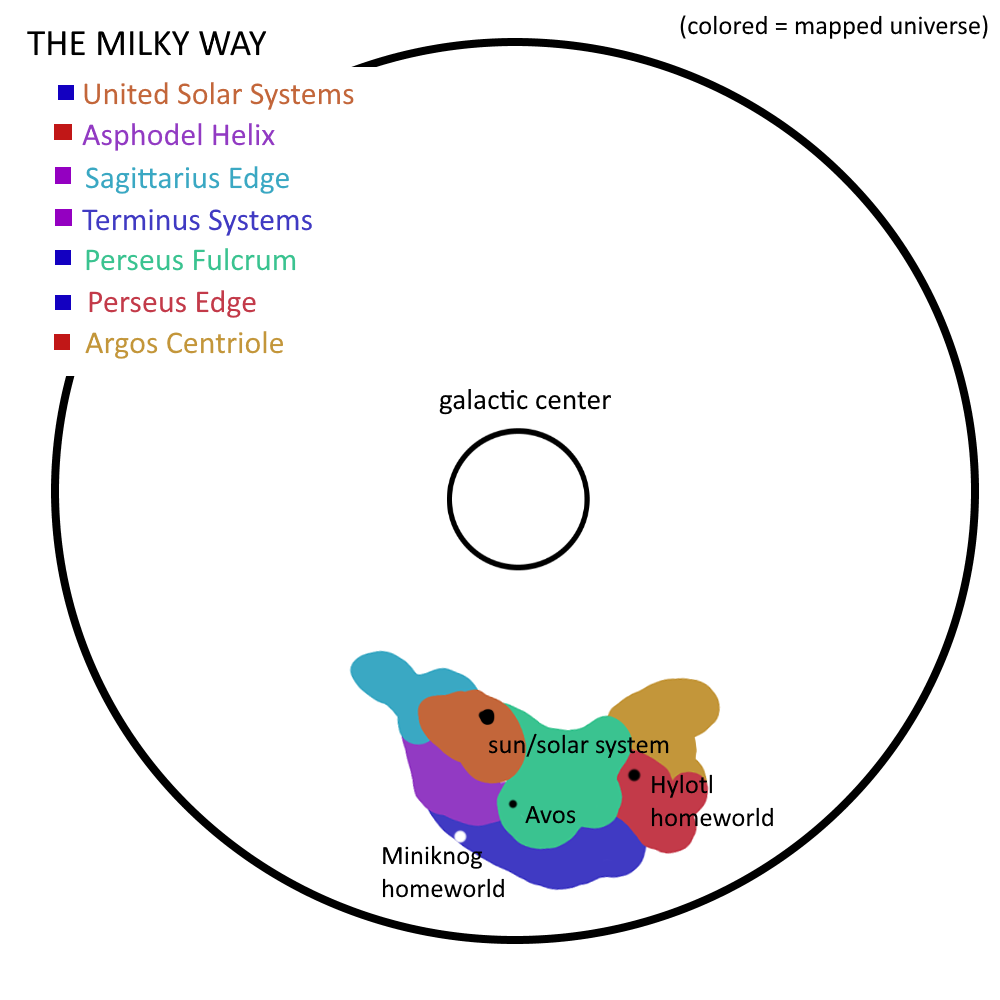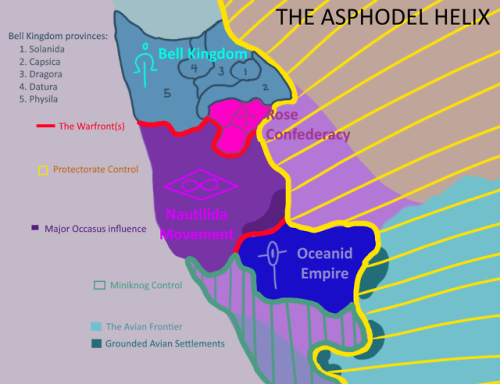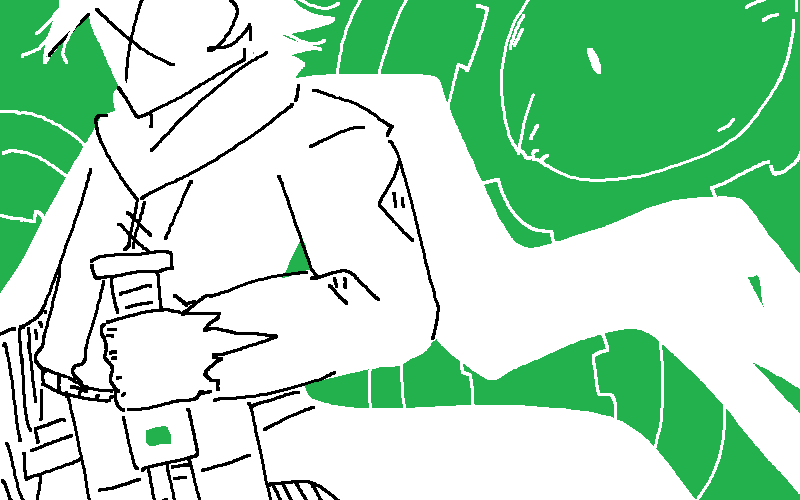THE UNIVERSE

The Asphodel Helix is the name of my personal Starbound world and storyline; while the universe is based on major aspects of the Chucklefish game, Starbound, I take a lot of personal liberties with the lore, timeline, and so on.
- The Known Universe: All of the stars that the Terrene Protectorate is able to see and map.
- The Mapped Universe: All of the stars that the Terrene Protectorate is able to actually establish contact with, whether it be through contacting existing civilizations on those planets or through new settlers/colonization missions to these systems.
- The Cosmic Frontier: Areas within the known universe, but outside of the mapped universe.
- The Unknown Universe: Areas entirely outside of the known universe.
After the defeat of the Ruin, the Protectorate was reestablished with a new bureaucratic system intended to prevent the total organizational gridlock that happened after the Ruin’s first attack and the death of the sole Grand Protector. The mapped universe was partitioned into various “zones,” as shown above, each zone being put under the jurisdiction of a group of administrative protectors that answer to a leading council of head protectors. The red, blue, and purple color coding refer to the volatility of a zone, with red being the most unstable and blue being the least (in terms of interspecies conflict, general planet/star danger ratings, political instability, etc.)
- The Perseus Edge is the zone in which most of the Hylotl-Floran war took place on, which has entered an uneasy stability since then because of the peace treaty hashed out at the end of the war.
- The Miniknog has control over most of the Terminus Systems, as well as parts of the Asphodel Helix and Perseus Fulcrum.
- Various weapons corporations have influence over different zones in the mapped universe. Kay's Shade Co. holds the most power in the Asphodel Helix; the Hylotl-run Xia-Li have power over the Perseus Edge; the Callox and Graxus brands are Miniknog-controlled and concentrated within the Terminus Systems; the Manaticon are the favored weapons of the U.S.C.M. in the United Solar Systems; the Rotik are generally popular across the Argos Centriole; the Necrolix originated on the Sagittarius Edge; and the Floran Teklacki are highly-esteemed in the Perseus Fulcrum.
THE ASPHODEL HELIX

This is the zone that my plot mainly focuses on. It's considered highly volatile because of the tensions between the factions of this region that’s led to war, a high volume of refugee movement, and a thriving smuggling/illegal black market. The current conflict in the region is referred to as the Origami War, where the Bell Kingdom, the Rose Confederacy, and the Oceanid Empire have entered a fragile alliance to fight against the Nautilida Movement.
The largest kingdom in the region is the Bell Kingdom, a monarchial Glitch kingdom that less conquers star systems and more… absorbs them, through trade or treaty, into its empire. Its people are called “Belloids"; native Belloid Glitches tend to be blockier and more built for strength than Rhodon Glitches. It’s divided up into the five major provinces you can see on the map: Solanida is the center of politics (hosting the capital city, Solana), Capsica is responsible for most trade, Dragora is largely education/research-based, Datura is… essentially a military province (with soldiers originating there known as the "devil's trumpets"), and Physila handles almost all agricultural/industrial output. The kingdom is ruled by the (self-aware) Glitch queen, Sunsteal Bellium.
The smallest kingdom in the region is the Rose Confederacy, which is actually a unity of three distinct kingdoms. They're collectively governed by the Rose Triad - a council of three Glitches (Waxwing Ironthorn, Steelfang Arcticbolt, and Crownlock Rootbreaker) who act as one ruler. Native Rhodon Glitches tend to be built more towards speed and grace than long, drawn-out fighting.
The Oceanid Empire is essentially a semi-democratic nation under the control of seven Hylotl collectively referred to as the Pleiades. They overthrew the former Glitch rulers in the area in order to establish their own government and reforms, and are currently the second-most technologically advanced empire in the Helix. The Oceanids are highly territorial, crushing dissidence and aggressively reacting to any perceived threats; they would be considered the largest threat in the Helix, but at the moment, they’ve maintained their peace for the sake of fighting against the Nautilida Movement.
The seven Pleiades are, as follows:
- Maia: Takumi Shiraki, leader of the Pleiades; responsible for most domestic policy and the creation of laws/methods of control
- Electra: Kohaku Ichikawa; keeps control over speech/press
- Taygete: Kiyoshi Okamura; regulates food production and industry
- Alcyone: Megumi Akiyama, second-most influential general; responsible for most of war planning and foreign policy
- Celaeno: Natsuki Minamoto; keeps track of most finances/trade/commerce
- Sterope: Rin Nishimoto; reinforces law and the justice system
- Merope: Midori Fujikawa, the weakest general; used almost entirely to break ties/as a figurehead
This is a movement that is, essentially, being puppeteered by the Occasus, who convinced a revolutionary group of Belloid Glitches that, through extreme physical/mental harm, any Glitch could be forced into self-awareness. (To be noted: this point is patently false.) Nautilida ideology has three main points: firstly, that a glitch deserves to be self-aware, and all necessary steps must be taken towards achieving full sentience/independence; secondly, that large-scale influences over the galaxy (read: the Terrene Protectorate) must be eliminated; and thirdly, that in order to preserve peace and cosmic balance, space travel should be extremely restricted in order to prevent interspecies interaction and, as they see it, inevitable conflict. They’ve taken over a large chunk of the Helix, but most people predict the movement to collapse in on itself very quickly due to infighting and a lack of formal leadership - however, it’s feared that this subsequent power vacuum will only cause further war between the Waxpetal Alliance and the Oceanids.
A group of largely untouched/”frontier” planets, home to a high population density of Avians that face high military pressure from the Oceanids and the Miniknog. This territory is further divided into the Grounded, located on a few systems in the south of the territory, and the Believers, who make up most of the rest. A Stargazer council of Avians has loose governmental control over the entire region; outside races are allowed to settle as long as they offer periodic tribute towards Kluex and pay taxes to the council and main governmental planets of the frontier, which are located in the northwest of the territory in the Hawk’s Gaze System. They've declared themselves strictly neutral to the war, and are under official Protectorate jurisdiction within the Helix - under Protectorate law, many of the systems within the Avian Frontier have been (legally) barred from any outside settlement or interference.
The Miniknog take the title of the most technologically-advanced influence within the Helix. Miniknog control in the area is firmly established by a system of “watchtower systems”, where armed Miniknog ships and guards patrol in order to both keep out the Origami War and keep in the Apex subjects of its rule. The Apex within this region live in a sort of “bubble” - very few of them actually have any awareness of the conflict within the Asphodel Helix.
The Terrene Protectorate is a largely neutral force in the Helix, at the moment - it’s refused to declare war against the Nautilidae, in fear that it will lead to increased targeting of Protectorate ships and refuges. Most Protectors working within the Helix either serve as explorers/mappers (determining if planets are safe enough for refugees to resettle on), soldiers (attempting to fight off Nautilidae extremists or guard existing refugee planets), or administrators (organizing refugee data and determining where new refugees can settle). Protectorate refuges are extremely well-guarded, in fear of Nautilidae or Occasus attacks.
- The Rose Confederacy and Bell Kingdom have been united as allies for hundreds of years under the Waxpetal Treaty. Both kingdoms have adopted advanced technology, while retaining medieval forms of society and government.
- Because of the Origami War, a black-market and smuggling society has become extremely prevalent within the Helix; illegal, experimental weapons for self-defense, expensive ferrying services to get people off of planets, personal guards/militias, etc. are all very common, despite Protectorate attempts to suppress it. Shade Co. is the most (in)famous example of this.
- Spies for… literally every side, even the Avians, are basically everywhere. The Nautilidae are most notorious for their sleeper agents: essentially, individuals/families of Nautilidae are planted on other planets and expected to integrate completely, until they’re called upon for either suicide missions or to return with the new intel they've gathered.
- Crime and violence rates, even outside of the Origami War, are very high due to the scavengers, outlaws, etc. looking to make quick pixels out of desperate planets, desolate systems, and frantic travelers.
- Despite the Protectorate being generally favorably regarded in the known universe, there’s a vocal subsection of people that make the point that placing star systems under a (majority human) organization’s “protection” is an extension of human imperialism and colonialism, and campaign for the dissolution of the Protectorate/free travel between the “zones” of star systems it’s created.
- The Floran and Novakid have no solid territory within the system, due to their races never having a clear concept of government/bureaucracy; their settlements are scattered both inside and out of the other races’ territories.
HISTORY
The Cultivator and the Ruin fought each other ages before the full evolution and development of the six races; when the artifacts were first distributed, only the Novakid (that had been immediately created upon the Cultivator’s destruction) had taken a form that would still be considered recognizable, today. The other six races were still in various stages of evolutionary infancy; their artifacts were merely hidden in the areas that would later be developed into the buildings and structures that the Protectorate found them in hundreds of thousands of years later.
The VEP inoculation project was what allowed the Apex to become the first race to develop space-travel technology; they’ve remained in the lead of the universal technological “race” ever since. Located in what would later be known as the Terminus Systems, they were the first to establish interplanetary contact with any other race -- namely, humans. Humans were second to make this breakthrough, after having been granted the necessary technology from Apex researchers and engineers.
The Hylotl and Floran, if they weren’t busy having the Malachite War, would likely have preceded the Apex in establishing contact with humans simply due to their relative proximity to the Earth’s solar system; the Hylotl developed FTL technology only a few years after the Apex did, and the Floran rapidly picked up after them, modifying Hylotl technology to fit their own highly-organic needs. The Malachite Wars were escalations of simple territorial and planetary disputes, taking place primarily in the modern Perseus Edge; the Hylotl decided to retreat underwater and to the coasts largely by their own accord, while the Floran remained on land and in the forests, an agreement later referred to as the Malachite Treaty. The two races, in an effort to maintain unity and peace, launched interplanetary missions together, reaching the humans and Apex a few decades after human-Apex initial contact. These four races established the primitive beginnings of the Terrene Protectorate.
Grounded and Kluexist Avians, in a joint effort to research space and flight technology, developed FTL technology last using the Avolite crystals that were present on their homeworld of Avos. They, surprisingly, were the first race to contact the scattered Novakid settlements throughout the universe; the Novakid, never having independently developed space travel, modded Avian ships and improved Avian technology, becoming the first race to establish contact with all six others. The Avians followed, finally completing the modern Terrene Protectorate around a century after space travel was first developed.
A few centuries after the Terrene Protectorate’s establishment was the attack of the Ruin, which lasted around six months; in this time period, most of the planets in the United Solar Systems were consumed by the Ruin, and it had begun to threaten the edges of the Terminus Systems and Asphodel Helix before Pollux Vautilos managed to destroy it. The Nautilidae were established in this time frame, and the Origami War - the war between the Nautilida Movement and the other influences within the Asphodel Helix - began only three months before the death of the Ruin. The current events of the story take place around half a year from the Origami War’s beginnings.
RACE BIOLOGY
The universal time of the mapped universe uses the PY/Protectorate Year, established by the Terrene Protectorate; it’s based on the location of the solar system as it rotates around the galactic center of the Milky Way (the Protectorate was initially established by humans and thus remained very human-centric).
- 1 PY = 1 hundreth-millionth of a cosmic year = ~2.5 Earth years = the time it takes for the solar system to travel 18 gigameters around the galactic center
- Humans have adapted to replace the Earth year with the PY; legal adulthood is granted at 8 PY.
Florans measure their age based on the summers passed on their planets; adulthood is measured by sexual maturity (which happens typically around ~15 summers/6 PY). Florans reproduce largely through pollination and the bearing of “seeds” that sprout into younger Florans; they're sequential hermaphrodites, with individuals adapting male/female plant sex organs based on need and thus having no innate gender. Late spring/early summer is considered the Florans’ peak reproductive season, with darker-colored Florans reproducing later into the season and pollination ending generally around mid-autumn. Theoretically, Florans are like crocodiles, in that they can grow as big/live as long as their environment allows them to - however, as they age, they tend to settle down, and the oldest Florans enter a sort of "hibernation" where they slowly lose mental/animal-like function in exchange for a plant-like state.
Hylotl tend to live longer than humans, with the oldest reaching around 50-60 PY; however, they reach sexual maturity more quickly, at around 5-6 PY, and are granted legal adulthood at 7 PY. They mate similarly to frogs, with their sex characteristics adapting based on external pressures (the ratio of feminine/masculine Hylotl around them) and many eggs being laid at one time; however, very few Hylotl children live past their egg stage. Also similarly to frogs, their infants have to be kept almost entirely submerged in water when young, until their lungs develop fully and their gills “close off.”
The Apex are the most human-like out of all the alien species, although they have shorter lifespans -- only averaging around 30 PY, compared to humans’ 40. They were one of the first races (besides humans) to fully adapt the PY as their official system of time, having used their home planet’s day/year as their personal universal time before that policy was enacted. They reach legal adulthood at 6 PY.
The Glitch were created by the Ancients, and their biology is... literally just incredibly advanced technology that forms sentient automatons. They have inbuilt clocks tuned to fit the galactic year, and measure their ages precisely, in parts of the galactic year. Glitch are created as functioning adults, and can theoretically live forever, as long as their mechanical parts regularly undergo maintenance/are replaced. Glitch innately have no sense of sex or gender, and may decide to choose their own.
Avians are among the shorter-lived species, reaching sexual maturity at 4 or 5 PY and only living up to 20-25 PY. They reproduce like birds, using eggs; newborn Avians resemble altricial birds (being completely featherless and blind), and keep their close familial bonds throughout both childhood and adulthood. Their history was based on years before/after Kluex (BK, AK) and on the time system from their home planet, Avos; many Kluexist Avians continue to use this system, while most Grounded have swapped to using the PY. Male Avians tend to be more brightly-colored, and female Avians tend to be duller.
Novakids don’t typically measure their age, as they reproduce through fusion, with the resultant energy from their fusion occasionally being enough to produce entirely new Novakids; these “Novalings” start off initially as just bright balls of energy, and very few are able to gather the necessary trace materials from the air around them to form their brands, the “cores” their beings are centered around. Their form is held together by “shells” of relatively-solid, lava-like energy that surround their main body; however, their extremities (hair, fingers, etc.) can be manipulated if the Novakids wish to. Novalings solidify and reach their adult forms days after their creation if their brands are successfully formed, and age/maturity is judged based on the relative brightness of a Novakid, with duller Novakids being older than brighter ones. Like real stars, bluer Novakids typically burn the fastest (~100 PY) and red Novakids the slowest (~2000 PY). Novakids typically either die because of broken brands (which destabilizes their bodies) or shattered shells (which allows their energy to leak out). Very few die of age; if so, they create a miniature supernova, where the Novakid literally collapses inwards on themselves. Their “voice” is created through complex vibrations of their brand, and theoretically, they can imitate any sound or voice - although their voices characteristically have a metallic “echo” to them. Novakids innately have no sex or gender, and may decide to choose their own.


